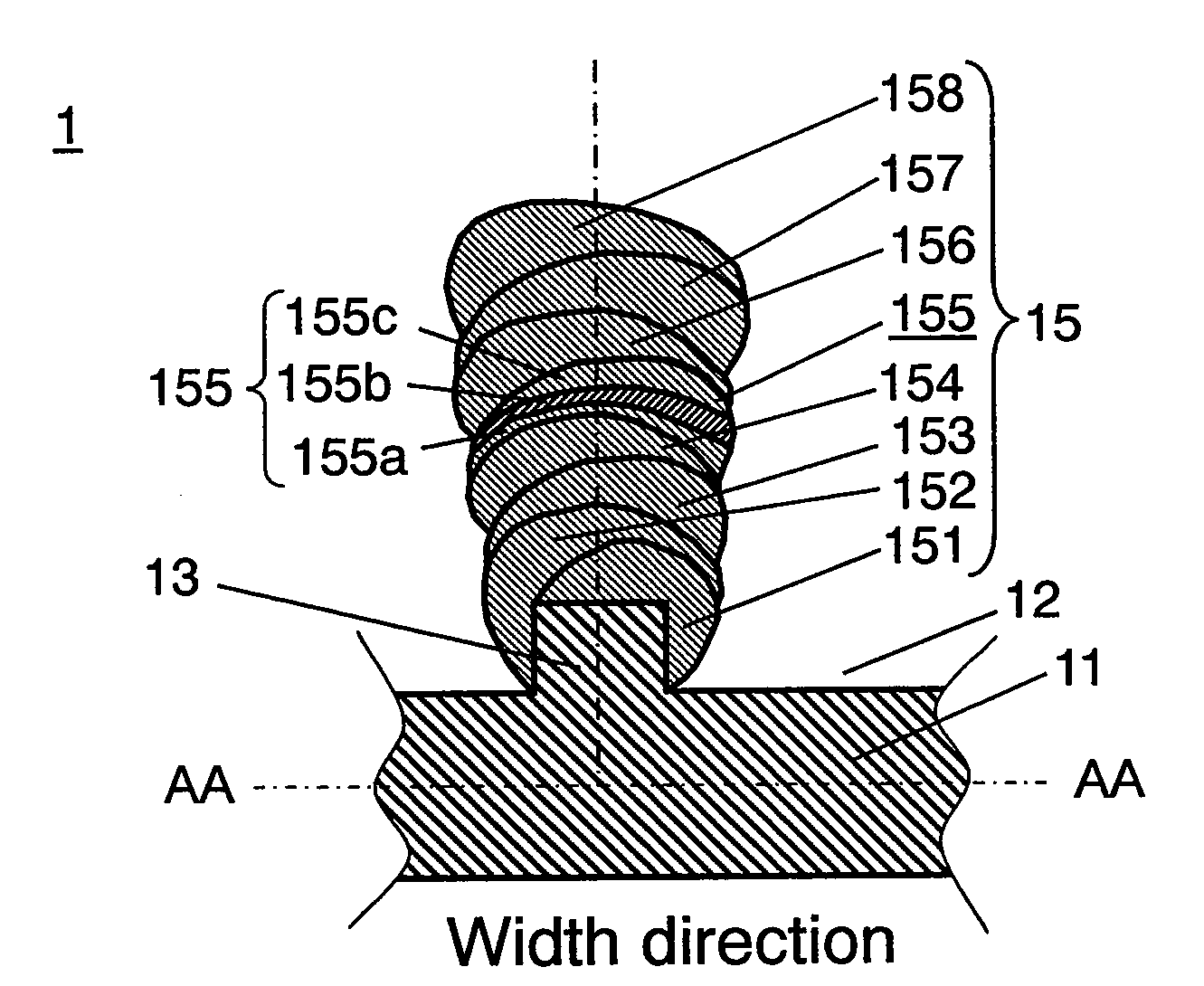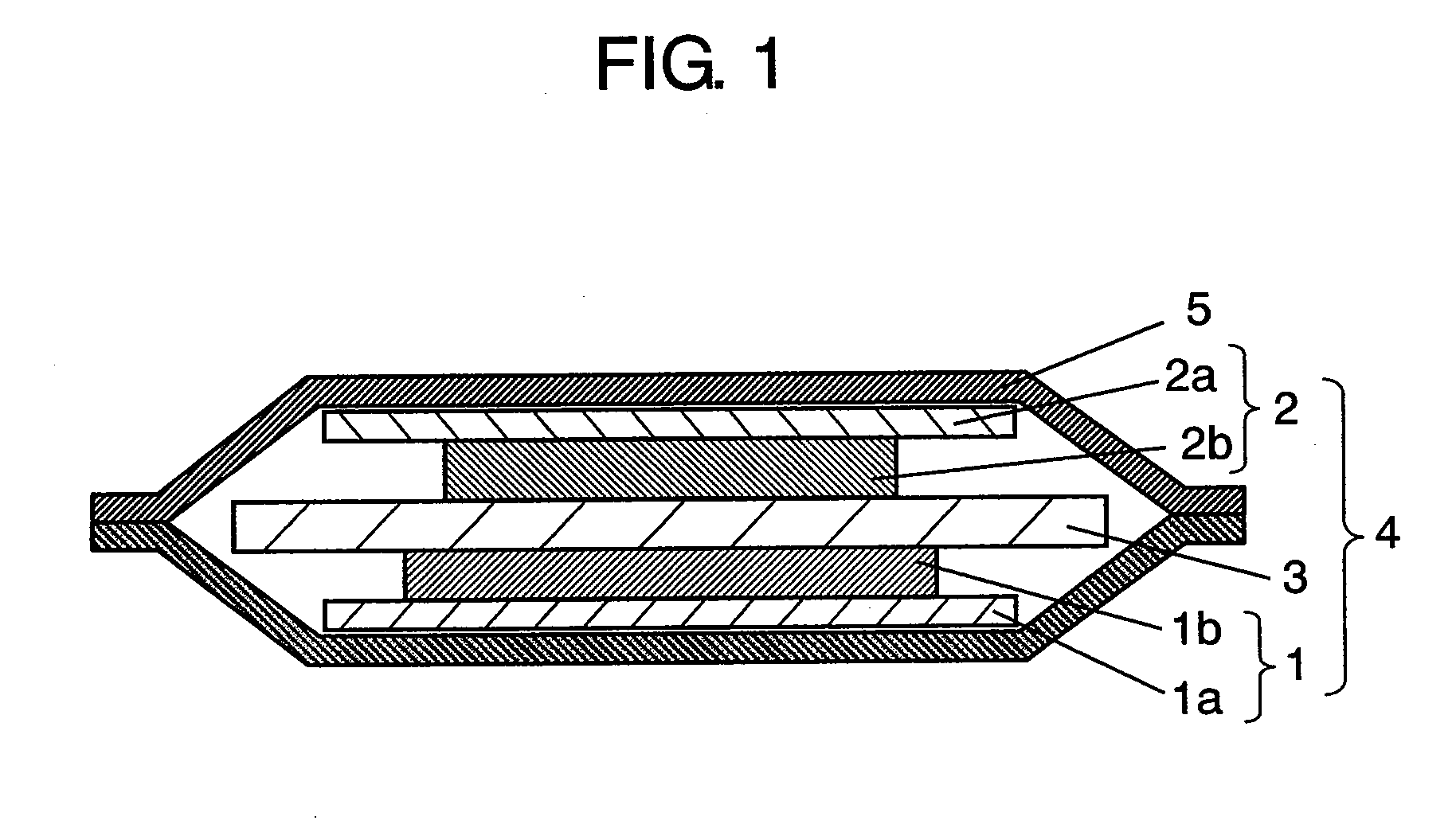Negative electrode for nonaqueous electrolyte secondary battery, its manufacturing method, and nonaqueous electrolyte secondary battery using the same
a technology of nonaqueous electrolyte and secondary batteries, which is applied in the direction of electrode manufacturing processes, electrochemical generators, cell components, etc., can solve the problems of reducing the capacity, increasing the volume of elements, peeling, etc., and achieves the effect of suppressing the change in the shape of column members, easy manufacturing of highly reliable negative electrodes, and maintaining spa
- Summary
- Abstract
- Description
- Claims
- Application Information
AI Technical Summary
Benefits of technology
Problems solved by technology
Method used
Image
Examples
first exemplary embodiment
[0054]FIG. 1 is a sectional view of a nonaqueous electrolyte second battery in the first exemplary embodiment of the present invention.
[0055]As shown in FIG. 1, the laminate type nonaqueous electrolyte secondary battery (hereinafter referred to as battery) is provided, as described in detail later, with negative electrode 1, positive electrode 2 for reduction of lithium ion during discharge, which is opposed to negative electrode 1, and electrode group 4 formed of porous separator 3 disposed therebetween to prevent negative electrode 1 and positive electrode 2 from coming into direct contact with each other. Electrode group 4 and nonaqueous electrolyte (not shown) having lithium ion conductivity are housed in outer case 5. The nonaqueous electrolyte having lithium ion conductivity is contained in separator 3. Also, positive electrode current collector 2a and negative electrode current collector 1a are connected with one end of positive electrode lead (not shown) and negative lead (n...
second exemplary embodiment
[0154]The structure of a negative electrode in the second exemplary embodiment of the present invention will be described in the following by using FIG. 10A to FIG. 10C.
[0155]FIG. 10A is a partially sectional schematic view showing the structure of the negative electrode in the second exemplary embodiment of the present invention. FIG. 10B is a schematic view for describing the change in value x in the width direction of active material of each columnar portion in the second exemplary embodiment of the present invention. FIG. 10C is a schematic view for describing the change in value x in the height direction of active material of each columnar portion in the second exemplary embodiment of the present invention. In this exemplary embodiment, a laminate type battery the same as shown in FIG. 1 is used, and the detailed description is omitted. Also, the component materials for the positive electrode mixture layer, positive electrode current collector, current collector, and columnar p...
third exemplary embodiment
[0241]The structure of a negative electrode in the third exemplary embodiment of the present invention will be described in the following with reference to FIG. 16A to FIG. 16C.
[0242]FIG. 16A is a partially sectional schematic view showing the structure of the negative electrode in the third exemplary embodiment of the present invention. FIG. 16B is a schematic view for describing the change in value x in the width direction of active material of each columnar portion in the third exemplary embodiment of the present invention. FIG. 16C is a schematic view for describing the change in value x in the height direction of active material of each columnar portion in the third exemplary embodiment of the present invention. In this exemplary embodiment, a laminate type battery the same as shown in FIG. 1 is used, and the detailed description is omitted. Also, the component materials for the positive electrode mixture layer, positive electrode current collector, current collector, and colum...
PUM
| Property | Measurement | Unit |
|---|---|---|
| oblique angle θ2 | aaaaa | aaaaa |
| width | aaaaa | aaaaa |
| width | aaaaa | aaaaa |
Abstract
Description
Claims
Application Information
 Login to View More
Login to View More - R&D
- Intellectual Property
- Life Sciences
- Materials
- Tech Scout
- Unparalleled Data Quality
- Higher Quality Content
- 60% Fewer Hallucinations
Browse by: Latest US Patents, China's latest patents, Technical Efficacy Thesaurus, Application Domain, Technology Topic, Popular Technical Reports.
© 2025 PatSnap. All rights reserved.Legal|Privacy policy|Modern Slavery Act Transparency Statement|Sitemap|About US| Contact US: help@patsnap.com



